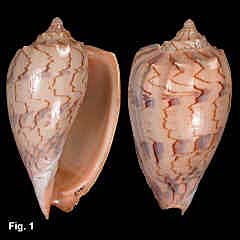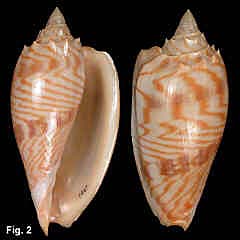|
|
|
|
|
Amoria hunteri (Iredale, 1931) Description: Shell moderately lightweight; whorls sharply angled, with a row of spines at shoulder, these becoming obsolete on last third of the body whorl; otherwise smooth and glossy. Aperture more than three-quarters total shell length; columella with four strong plaits with undercut sides. Outer lip flared, thickened internally along its entire length. Background colour fawn to reddish-orange, marked with axial zigzag brown lines and spiral bands of purple-grey patches, although either may be absent or poorly developed. Size: Adults 85-186 mm, commonly 90-140 mm in length. Distribution: Endemic to Australia; Capricorn Channel, off Townsville, Queensland, to Eden, NSW, with an isolated population around Pith Reef, off Innisfail, Queensland (Bail & Limpus, 2001). Habitat: Known from 25-225 metres, and rarely as a beach shell. Commonly taken off Sydney in about 100 metres. Remarks: This species exists as a northern deep water form and a southern shallow water form, as described by Bail & Limpus (2001). According to these authors, the northern population (Fig. 2) occurs in 180-225 m from the Capricorn Channel and eastern Swain Reefs, southwards to about the NSW-Queensland border. The southern population (Fig. 1) occurs in 25-90 m from Fraser Island in southern Queensland to around Eden in the far south of NSW. Bail & Limpus describe the differences between the two populations:
Fig. 1. Off Sydney in 30 fathoms (55 m) (DLB2041) Fig. 2 Capricorn Channel, NE of Lady Musgrave Is, Queensland, in 120 fathoms (219 m) (DLB1947)
|

